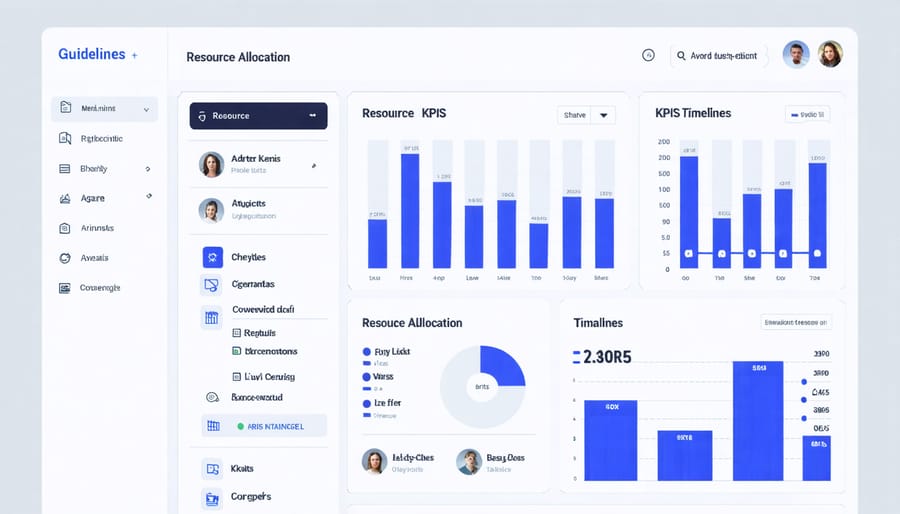Transforming major infrastructure projects through successful public-private partnerships demands a precise, methodical approach that maximizes both public benefit and private sector innovation. The three-step framework—Assessment, Alignment, and Implementation—has emerged as the industry standard for structuring these complex collaborations. Through rigorous risk assessment and clear accountability metrics, this systematic process ensures optimal resource allocation while maintaining transparency throughout the project lifecycle. Drawing from decades of construction industry experience and proven case studies across multiple continents, this framework has consistently delivered results in projects ranging from transportation infrastructure to healthcare facilities. By following these carefully calibrated steps, organizations can create sustainable partnerships that leverage private sector efficiency while safeguarding public interests, ultimately delivering infrastructure projects that serve communities more effectively and economically than traditional procurement methods.

Step 1: Initial Assessment and Planning Phase
Risk Assessment and Resource Allocation
The second critical step in establishing a successful public-private partnership involves comprehensive risk assessment and strategic resource allocation. Both public and private entities must conduct thorough evaluations of potential risks, including financial exposure, construction delays, regulatory compliance issues, and market fluctuations. This assessment typically involves quantitative analysis tools and risk matrices to identify, categorize, and prioritize various risk factors.
Resource allocation follows risk assessment and requires careful consideration of each partner’s capabilities and constraints. Private sector partners generally contribute technical expertise, operational efficiency, and financial capital, while public sector entities provide regulatory support, land access, and necessary permits. The distribution of resources should be clearly documented in the partnership agreement, with specific attention to financial commitments, personnel assignments, and equipment allocation.
A well-structured risk-sharing mechanism is essential, typically following the principle that risks should be assigned to the party best equipped to manage them. For instance, construction and operational risks are often better managed by private partners, while regulatory and political risks typically fall under public sector responsibility. This approach optimizes resource utilization and enhances project efficiency while ensuring both parties maintain appropriate levels of control and accountability throughout the project lifecycle.
Legal Framework Development
The development of a robust legal framework forms the cornerstone of successful public-private partnerships in construction projects. This critical phase requires careful consideration of contractual obligations, risk allocation, and compliance requirements. A well-structured legal agreement should clearly define the roles, responsibilities, and expectations of both public and private entities throughout the project lifecycle.
Key elements of the legal framework include detailed provisions for project financing, performance metrics, dispute resolution mechanisms, and exit strategies. The agreement must address essential aspects such as intellectual property rights, liability limitations, and force majeure conditions. Public sector stakeholders should ensure compliance with relevant procurement laws and regulations, while private partners need assurance of their investment protection and operational autonomy.
Risk sharing mechanisms must be explicitly outlined, with clear delineation of which party assumes specific project risks. This includes construction delays, cost overruns, regulatory changes, and operational challenges. The framework should also establish governance structures, reporting requirements, and monitoring mechanisms to ensure project transparency and accountability.
Legal experts recommend incorporating flexibility mechanisms to accommodate potential changes in project scope or regulatory requirements while maintaining the partnership’s fundamental objectives. This adaptability helps ensure long-term project sustainability while protecting the interests of all stakeholders involved.
Step 2: Implementation and Governance Structure
Establishing Joint Management Systems
Creating effective management protocols between public and private entities requires careful planning and structured implementation. The process begins with establishing a joint governance framework that clearly defines roles, responsibilities, and decision-making authorities for both parties. This framework should include detailed operational procedures, communication channels, and reporting mechanisms.
Key components of the joint management system include creating integrated project teams, implementing shared digital platforms for documentation and communication, and developing standardized processes for issue resolution. Regular steering committee meetings, comprising representatives from both sectors, ensure alignment of objectives and swift decision-making.
Success depends on implementing robust performance monitoring systems that track progress against predetermined metrics. These systems should incorporate both quantitative measures, such as project milestones and financial targets, and qualitative assessments of partnership effectiveness.
Risk management protocols must be clearly defined, with specific procedures for identifying, assessing, and mitigating potential challenges. This includes establishing contingency plans and defining escalation pathways for critical issues. Regular review and optimization of these systems ensure continuous improvement and adaptation to changing project needs, ultimately fostering a more efficient and productive partnership.
Performance Metrics and Monitoring
Effective performance monitoring in public-private partnerships requires establishing clear, measurable metrics from the outset. Key Performance Indicators (KPIs) typically include construction timeline adherence, cost management efficiency, quality standards compliance, and safety performance metrics. These indicators should be quantifiable and aligned with both public sector objectives and private partner expectations.
Regular oversight mechanisms must be implemented through a structured monitoring framework. This includes monthly progress reports, quarterly performance reviews, and annual comprehensive assessments. Independent third-party evaluators often conduct these assessments to ensure objectivity and transparency in measuring project outcomes.
Financial metrics play a crucial role, encompassing return on investment (ROI), operational cost efficiency, and revenue generation targets. Environmental and social impact metrics have also become increasingly important, measuring factors such as carbon footprint reduction, community engagement levels, and local economic benefits.
A robust monitoring system should include:
– Real-time data collection and reporting tools
– Clear escalation protocols for performance issues
– Regular stakeholder communication channels
– Documented compliance with regulatory requirements
– Risk management tracking systems
The success of performance monitoring depends on establishing clear baseline measurements, setting realistic targets, and maintaining consistent evaluation methods throughout the project lifecycle. This ensures accountability and enables timely corrective actions when necessary.

Step 3: Long-term Partnership Sustainability
Continuous Evaluation and Adaptation
Regular assessment and adaptation are crucial components of successful public-private partnerships in construction. Implementing robust sustainable partnership strategies requires continuous monitoring through key performance indicators (KPIs) and milestone evaluations.
Construction industry leaders recommend quarterly performance reviews that examine both quantitative metrics, such as project timelines and budget adherence, and qualitative factors, including stakeholder satisfaction and community impact. These evaluations should utilize standardized assessment tools while remaining flexible enough to accommodate project-specific requirements.
Data collection should focus on critical areas such as financial performance, operational efficiency, risk management effectiveness, and environmental compliance. Regular stakeholder feedback sessions, including input from both public and private entities, help identify areas for improvement and potential optimization opportunities.
Adaptation protocols should be clearly defined in the partnership agreement, allowing for swift implementation of necessary changes. This might include provisions for technology upgrades, regulatory compliance adjustments, or modifications to project scope based on emerging needs.
Success in this phase depends on maintaining open communication channels and establishing a formal change management process. Partners should document lessons learned and best practices, creating a knowledge base that supports continuous improvement and informs future partnership initiatives.

Stakeholder Management and Communication
Effective stakeholder management and communication form the cornerstone of successful public-private partnerships in construction projects. The process begins with identifying all key stakeholders, including government agencies, private investors, contractors, local communities, and end-users. A comprehensive stakeholder register should document their interests, influence levels, and potential impact on project outcomes.
Regular communication channels must be established through structured meetings, progress reports, and digital platforms. These channels should facilitate transparent information sharing while maintaining confidentiality where required. Project managers should implement a communication matrix that clearly defines who needs what information, when they need it, and how it should be delivered.
Engagement strategies should be tailored to each stakeholder group. For instance, technical updates for engineering teams require different approaches than community outreach programs. Documentation of all stakeholder interactions, decisions, and commitments is crucial for maintaining accountability and tracking engagement effectiveness.
Risk mitigation in stakeholder management involves early identification of potential conflicts and the development of resolution protocols. Regular feedback loops enable continuous improvement of communication strategies and help maintain stakeholder satisfaction throughout the project lifecycle.
Success in stakeholder management often hinges on cultural awareness, especially in projects involving multiple jurisdictions or international partnerships. Building trust through consistent, honest communication and demonstrable progress toward shared goals remains paramount for sustainable stakeholder relationships.
The successful implementation of public-private partnerships in construction projects hinges critically on the careful execution of these three fundamental steps. When followed diligently, this structured approach significantly reduces project risks, enhances stakeholder alignment, and maximizes the potential for successful outcomes. Industry data consistently shows that partnerships adhering to these steps demonstrate higher completion rates, better cost management, and improved stakeholder satisfaction.
The systematic progression from initial assessment through detailed planning to implementation creates a robust framework that addresses the complex challenges inherent in construction PPPs. By conducting thorough feasibility studies, establishing clear governance structures, and maintaining transparent communication channels, organizations can build sustainable partnerships that deliver value for both public and private entities.
Experience from numerous successful projects worldwide demonstrates that skipping or rushing through any of these steps often leads to complications, delays, and cost overruns. The interconnected nature of these steps ensures that critical aspects of the partnership, from risk allocation to performance monitoring, are properly addressed and managed throughout the project lifecycle.
Looking forward, as infrastructure needs continue to grow and public resources remain constrained, the importance of well-structured PPPs will only increase. Organizations that master these three steps position themselves to capitalize on future opportunities while delivering projects that serve their communities effectively. The investment in following this structured approach pays dividends through reduced disputes, streamlined execution, and enhanced project outcomes that benefit all stakeholders involved.

